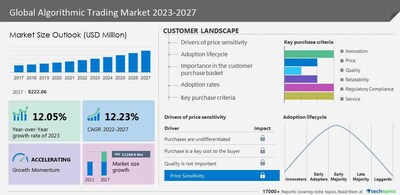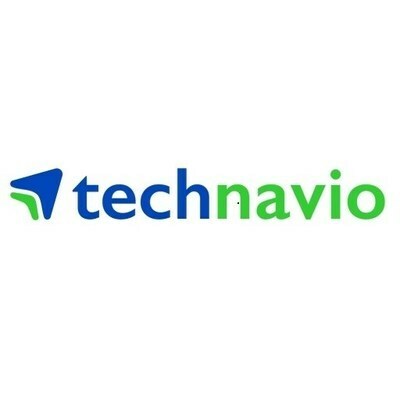Algorithmic Trading Market size is set to grow by USD 11190.9 million from 2023-2027, high demand for market surveillance boost the market, Technavio
Press Releases
Apr 18, 2024
NEW YORK, April 18, 2024 /PRNewswire/ — The global algorithmic trading market size is estimated to grow by USD 11190.9 million from 2023-2027, according to Technavio. The market is estimated to grow at a CAGR of 12.23% during the forecast period. The algorithmic trading market is experiencing heightened demand for market surveillance due to compliance requirements. Top vendors are enhancing data management strategies and addressing system gaps. International and regional interdependencies are crucial for accessing optimal assets. Strategies include building high-risk infrastructures, augmenting equity markets, and leveraging technologies like AI, cloud solutions, and blockchain. Key players focus on business agility, automation, and market integrity to mitigate risks such as flash crashes and human error.
For more insights on the historic (2017 – 2021) and forecast market size– Request a sample report
|
Algorithmic Trading Market Scope |
|
|
Report Coverage |
Details |
|
Base year |
2022 |
|
Historic period |
2017 – 2021 |
|
Forecast period |
2023-2027 |
|
Growth momentum & CAGR |
Accelerate at a CAGR of 12.23% |
|
Market growth 2023-2027 |
USD 11190.9 million |
|
Market structure |
Fragmented |
|
YoY growth 2022-2023 (%) |
12.05 |
|
Regional analysis |
North America, Europe, APAC, South America, and Middle East and Africa |
|
Performing market contribution |
North America at 35% |
|
Key countries |
US, China, Japan, UK, and Germany |
|
Key companies profiled |
63 moons Technologies Ltd., AlgoBlocks, AlgoBulls Technologies Pvt. Ltd., AlpacaDB Inc., Argo SE, Auros, CRYPTO TECHFIN SL, InfoReach Inc., iRageCapital Advisory Pvt. Ltd., MetaQuotes Ltd., QuantConnect Corp., QuantCore Capital Management LLC, Refinitiv, Software AG, Symphony Fintech Solutions Pvt. Ltd., Tata Consultancy Services Ltd., Thomson Reuters Corp., uTrade, Wyden AG, and VIRTU Financial Inc. |
Segment Overview
This algorithmic trading market report extensively covers market segmentation by Component (Solutions, Services ) End-user (Institutional investors, Retail investors, Long-term investors, Short-term investors ) Geography (North America, APAC, Europe, South America, Middle East and Africa)
Market segmentation by Component
The algorithmic trading market caters to institutional investors, including mutual funds, asset management firms, and capital markets firms. These organizations leverage algorithmic trading for high volume and large capital transactions in financial markets. Market surveillance technology and artificial intelligence (AI) power financial service algorithms, enabling automated trading through matching engines. Market integrity is ensured via market surveillance systems, preventing flash crashes and maintaining liquidity. Cloud technologies and cloud-based trading solutions offer business agility and cost savings. Acquisitions of software technology services and digital onboarding solutions facilitate the implementation of predefined rules and covert execution algorithms. Automated trading bots execute trades based on volume, price, and time, utilizing mathematical algorithms for stocks, bonds, currencies, and commodities. Human error is minimized through automation, ensuring market liquidity and market efficiency. Additionally, hybrid cloud solutions and blockchain technology enhance security and transparency.
Geography Overview
The Algorithmic Trading Market in North America has experienced substantial growth, driven by the financial markets’ continuous trade monitoring and surveillance. Algo trading, or the use of computer programmes and mathematical algorithms to execute trades based on predefined rules, is increasingly popular among hedge funds, institutional investors, pension funds, mutual funds, and other market participants. This market encompasses various assets, including stocks, bonds, currencies, and commodities. Automation in algorithmic trading reduces human error and enhances market liquidity, risk management, and market volatility handling. Market transparency, accountability, speed, and efficiency are essential benefits, making it accessible to large enterprises and capital markets firms. Algorithmic trading platforms, professional services, and cloud-based deployment are integral to this market’s growth. Regulatory oversight, such as the National Futures Association (NFA), ensures market integrity and prevents manipulations. Advanced technologies like artificial intelligence (AI), machine learning, and market surveillance technology are transforming financial service algorithms and automated trading. Cloud-based solutions and hybrid cloud deployments enable business agility and scalability. Despite challenges like flash crashes and liquidity concerns, algorithmic trading continues to evolve, shaping the stock market, cryptocurrency market, and other capital markets.
Insights on the market contribution of various segments including country and region wise, historic (2017 – 2021) and forecast market size– Download a Sample Report
- Algorithmic trading, also known as algo trading or black box trading, utilizes mathematical algorithms, predefined rules, and computer programs to execute trades in financial markets. This automation reduces human error, enhances market liquidity, and improves risk management. New technologies like liquidity aggregation and AI have decreased search costs, increasing accessibility for institutional investors in stocks, bonds, currencies, and commodities markets. Algo trading platforms offer cloud-based deployment, professional services, and market surveillance technology for large enterprises and capital markets firms.
- The APAC algorithmic trading market is in its early stages due to wider bid-ask spreads and market volatility in some stocks. Challenges include risk management, market transparency, and accountability. Parties aim to replicate US-Europe success with algorithmic trading platforms, professional services, and cloud-based solutions. Key areas include institutional investors, pension funds, mutual funds, market surveillance technology, AI, and automated trading. Challenges include flash crashes, liquidity, and market integrity. Solutions include matching engines, market surveillance technology, and cloud-based trading.
Insights on Market Drivers, trends, & Challenges, historic period(2017 – 2021) and forecast period(2023-2027)- Request a sample report!
Research Analysis
Algorithmic trading, also known as Algo trading, is a method used by institutional investors, including hedge funds, pension funds, and mutual funds, to make automated trades in financial markets such as stocks, bonds, currencies, and commodities. This approach employs predefined rules based on mathematical algorithms and computer programmes to identify trading opportunities and execute trades quickly and efficiently. The use of automation in algorithmic trading reduces human error and improves market liquidity, enabling effective risk management and market volatility mitigation. With the advent of artificial intelligence (AI) and financial service algorithms, as well as cloud-based solutions, algorithmic trading has become an essential tool in the financial services industry, particularly in the stock market and cryptocurrency market. Price fluctuations in these markets are closely monitored, and algorithmic trading systems help institutional investors capitalize on opportunities and manage risk in real-time.
Market Research Overview
In the Algorithmic Trading Market, algorithms play a pivotal role in executing trades based on predefined instructions. Algorithmic trading involves using computer programs to analyze financial data and execute trades at optimal times. The Algorithmic Trading Market comprises various components such as Algorithmic Traders, Brokers, Exchanges, and Regulators. Algorithmic Traders use complex mathematical models and statistical analysis to identify trading opportunities and execute trades. Brokers provide the necessary infrastructure for algorithmic trading, while Exchanges facilitate the buying and selling of financial instruments. Regulators ensure that algorithmic trading adheres to relevant laws and regulations. Professionals in this field, including traders, developers, and quants, employ tools like Python, R, and MATLAB for programming and data analysis. Markets for algorithmic trading include equities, futures, options, and forex. Programs like TradeStation, MetaTrader, and NinjaTrader are commonly used for algorithmic trading. Precision, speed, and efficiency are key benefits of algorithmic trading. However, it also carries risks such as market volatility and system failures.
About Technavio
Technavio is a leading global technology research and advisory company. Their research and analysis focuses on emerging market trends and provides actionable insights to help businesses identify market opportunities and develop effective strategies to optimize their market positions.
With over 500 specialized analysts, Technavio’s report library consists of more than 17,000 reports and counting, covering 800 technologies, spanning across 50 countries. Their client base consists of enterprises of all sizes, including more than 100 Fortune 500 companies. This growing client base relies on Technavio’s comprehensive coverage, extensive research, and actionable market insights to identify opportunities in existing and potential markets and assess their competitive positions within changing market scenarios.
Contacts
Technavio Research
Jesse Maida
Media & Marketing Executive
US: +1 844 364 1100
UK: +44 203 893 3200
Email: [email protected]
Website: www.technavio.com/
![]() View original content to download multimedia:https://www.prnewswire.com/news-releases/algorithmic-trading-market-size-is-set-to-grow-by-usd-11190-9-million-from-2023-2027–high-demand-for-market-surveillance-boost-the-market-technavio-302120444.html
View original content to download multimedia:https://www.prnewswire.com/news-releases/algorithmic-trading-market-size-is-set-to-grow-by-usd-11190-9-million-from-2023-2027–high-demand-for-market-surveillance-boost-the-market-technavio-302120444.html
SOURCE Technavio




